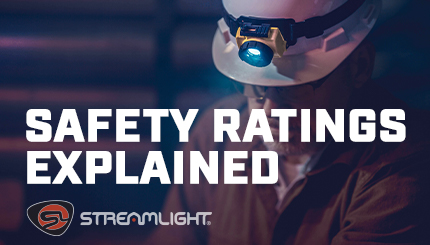Press Releases Detail
Safety-Rated Flashlights: How to Pick the Right Light
By Travis Bridgette, Sales Manager

Each year, the National Safety Council designates June as National Safety Month. This year, due to COVID-19, safety has been front and center with the majority of attention on Personal Protective Equipment (PPE). During this year’s safety month, we're going to discuss an area that can often be overlooked: flashlight safety and what to look for when choosing a safety-rated flashlight.
Understanding Class & Division
When choosing a safety-rated flashlight, it is important to understand the environment and atmosphere that the product is being used in. This allows you to determine what Class and Division are needed, as determined by the National Electric Code (NEC). Below is a brief overview of how the NEC defines hazardous locations by “Class” and “Division.” There are three classes:
Class I locations are those in which flammable gases, liquids, or vapors may be present.
Class II locations are hazardous because combustible dusts may be found.
Class III locations contain easily ignitable fibers or flyings.
The “Division” designation refers to the likelihood that ignitable concentrations of flammable materials are present. There are two divisions:
Division 1 designates an environment where ignitable concentrations of flammable gases, liquids, vapors, or dust exist some or all of the time under normal operating conditions, or where ignitable fibers and flyings exist.
Division 2 designates an environment where ignitable concentrations are not likely to exist under normal operating conditions or where Class III materials are stored or handled.
Hazardous classes and divisions are further subdivided into groups of hazardous materials. The groups define substances by rating their flammable nature in relation to other known substances. For additional details, please review NEC Section 500-5(a)(4) FPN No. 2.
Recently, a food and beverage end-user asked for an intrinsically safe flashlight because the current lighting product they were using was not holding up. The end-user was then asked about the environment they work in. Their response? That the light just needed to be safety-rated. This prompted more questions to ensure they were getting the right light. The Safety Manager informed us that the area has large amounts of sugar present, which is a combustible dust. That means this specific user would need a Class II, Division I rated flashlight to operate safely in this environment. If not asked more about the atmosphere, this end-user would have used a product that could potentially be an ignitable source, creating a safety hazard.
If you know you need a safety-rated light for use in your environment, make sure you investigate what hazards may be present in the environment you’ll be using it in to determine the ratings your light will need to have.
Features of the Flashlight
Once you have determined the safety ratings that meet the criteria of your work environment, it’s time to look at the basics of choosing the right light for your application. Some features to consider include the size and body material of the light, hands-free options, run time, lumen/candela output, spot or flood light, and battery versus rechargeable platforms. Your specific use case will determine which features of a light are most desirable, so be sure to think about how you’ll be using your flashlight when considering what light is right for you.
If you could be using a flashlight in a potentially hazardous location, it’s imperative that your light meets the specific safety rating for the environment you’ll be using it in. There are many locations where it can be dangerous to use a light that is not designed for a specific atmosphere, which is why understanding your environment and safety ratings is crucial. Ensure you get home safely every day by choosing a dependable brand that uses the highest standards to achieve safety ratings and performance in their safety-rated flashlights.

